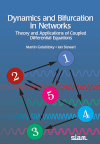- About MAA
- Membership
- MAA Publications
- Periodicals
- Blogs
- MAA Book Series
- MAA Press (an imprint of the AMS)
- MAA Notes
- MAA Reviews
- Mathematical Communication
- Information for Libraries
- Author Resources
- Advertise with MAA
- Meetings
- Competitions
- Programs
- Communities
- MAA Sections
- SIGMAA
- MAA Connect
- Students
- MAA Awards
- Awards Booklets
- Writing Awards
- Teaching Awards
- Service Awards
- Research Awards
- Lecture Awards
- Putnam Competition Individual and Team Winners
- D. E. Shaw Group AMC 8 Awards & Certificates
- Maryam Mirzakhani AMC 10 A Awards & Certificates
- Two Sigma AMC 10 B Awards & Certificates
- Jane Street AMC 12 A Awards & Certificates
- Akamai AMC 12 B Awards & Certificates
- High School Teachers
- News
You are here
Dynamics and Bifurcation in Networks

Publisher:
SIAM
Publication Date:
2023
Number of Pages:
870
Format:
Hardcover
Price:
129.00
ISBN:
978-1611977325
Category:
Monograph
[Reviewed by , on ]
Bill Satzer
10/9/2023
This ambitious text aims to pull together a cohesive picture of the theory and applications for networks of dynamical systems. This is an area where applications have arguably run well ahead of a general theory. The authors suggest that they are attempting to create a synthesis of common features found broadly in the research literature in order to describe not so much a “theory of everything” as a “theory of something”. Interest in network-based modeling has exploded in the last several years, in both theory and applications, with hundreds or even thousands of papers investigating one aspect or another.
That “theory of something” begins with a directed graph where each individual node represents a dynamical system (with an associated class of ordinary differential equations (ODEs)) and whose directed edges (arrows) represent couplings. The nodes and arrows are labeled with assigned types, so that nodes of the same type have the same internal dynamics, and arrows of the same type indicate the same sort of coupling. In many models the nodes represent state variables and the arrows capture interactions between variables.
The authors motivate the need for a general theory by describing the great diversity of network ODEs that have arisen in applications. They include specific applications in ecology (the food web representing interaction and predation among organisms), epidemic networks, genetic regulatory systems, brain circuitry, biochemical phenomena (dopamine synthesis, for example), and models for the control of diabetes. Applications in the life sciences are currently the most numerous. In the past, these networks were studied by exploiting special properties of the model equations and the topology of the network. Models were often treated in isolation, separate from models in other areas, and general features like symmetry and synchronization were not exploited in a systematic way.
Individual dynamical systems, especially nonlinear ones, can be very complicated themselves. Put in the context of networks of dynamical systems that can interact with one another at various levels, the complications multiply enormously. Is it possible to build a conceptually overarching view at this time in their development? Well, the authors give it a good shot. The first three chapters provide an introduction and orientation, and introduce bifurcations and how they are constrained by networks.
The following two big sections of the book discuss homogeneous networks (where nodes and couplings can essentially be considered the same dynamically) and inhomogeneous networks (where nodes and couplings can differ across the network).
As we get deeper into the book, we meet a collection of more advanced topics including synchrony and phase patterns across a network, symmetric networks and lattice networks, and then a bit about complex dynamics. Before this most of the dynamics has been steady-state or periodic. It’s here at the end where we find a discussion of heteroclinic cycles and chaos.
This is a long, dense (and heavy) treatment of a very complex subject. It requires, at minimum, a strong background in dynamical systems. With its extensive bibliography it will continue to be a reference to reckon with, but certainly not an easy place for newcomers to begin their explorations. Yet there are probably the roots here for a great number of future doctoral dissertations.
Bill Satzer (bsatzer@gmail.com), now retired from 3M Company, spent most of his career as a mathematician working in industry on a variety of applications. He did his PhD work in dynamical systems and celestial mechanics.
See the publisher's website.
- Log in to post comments




